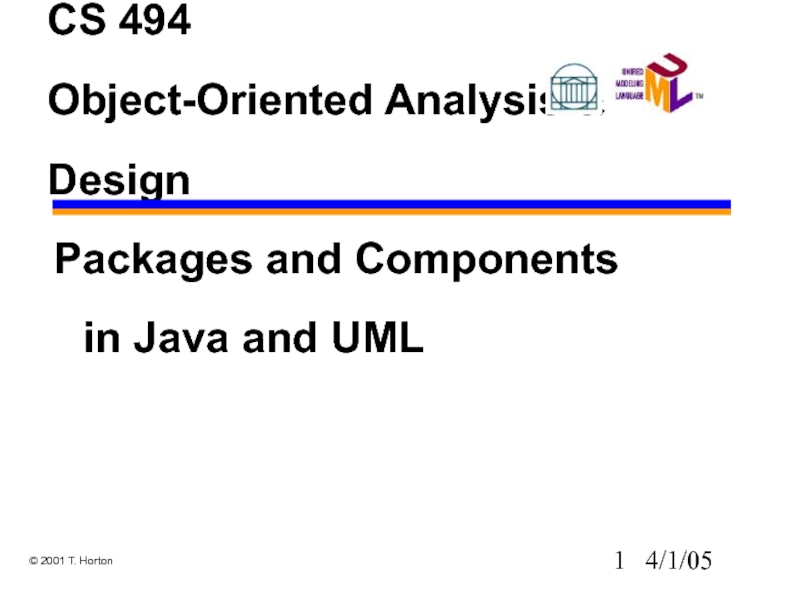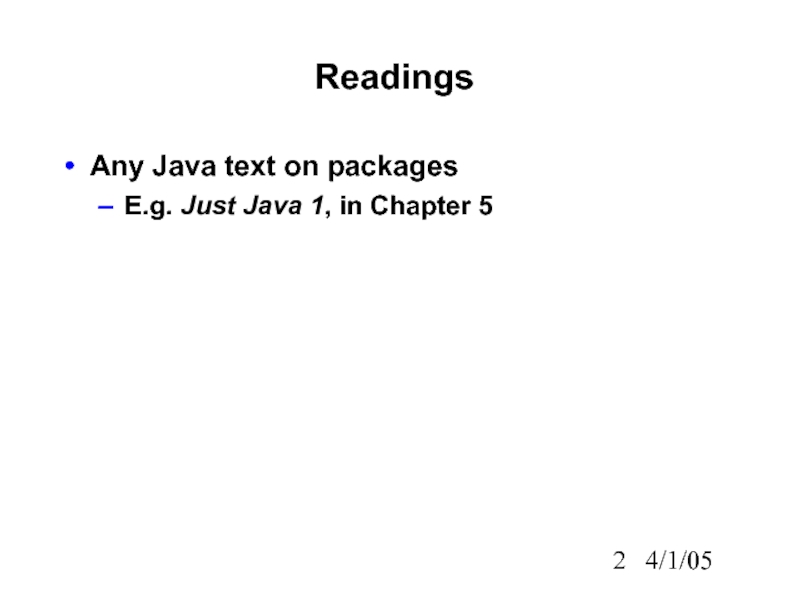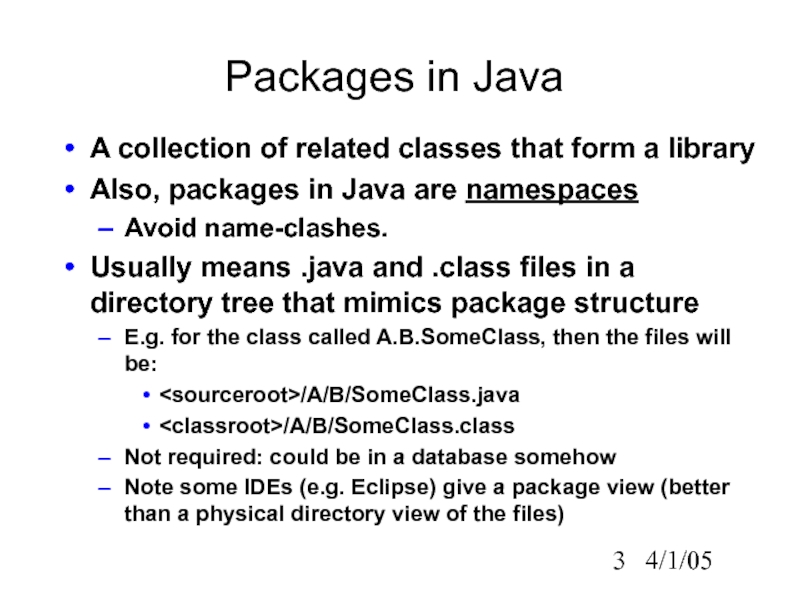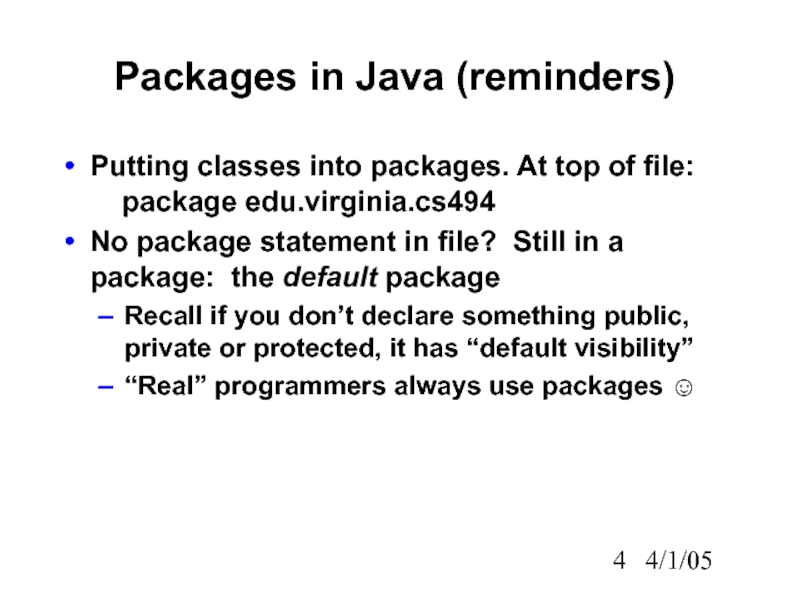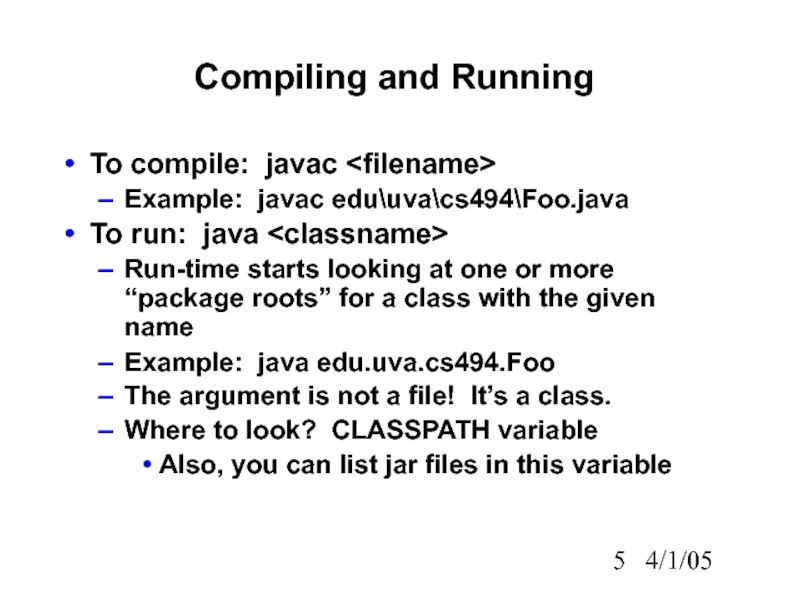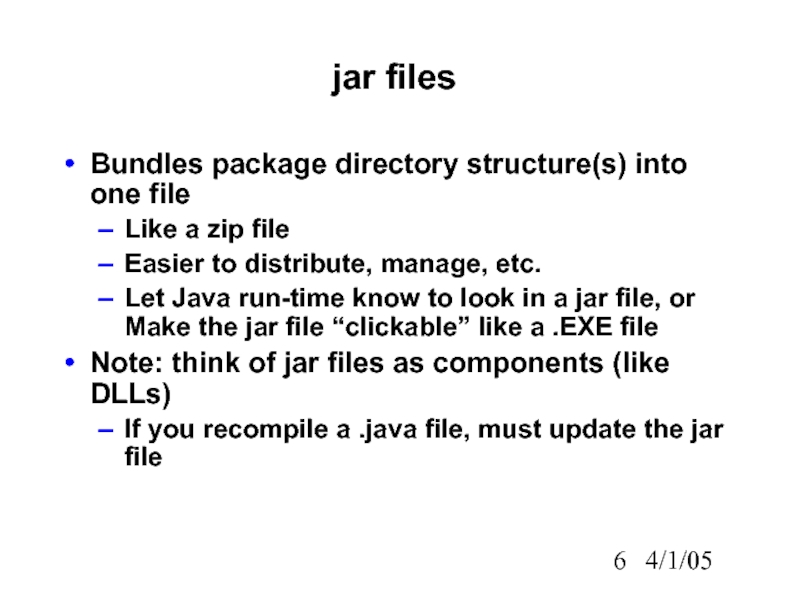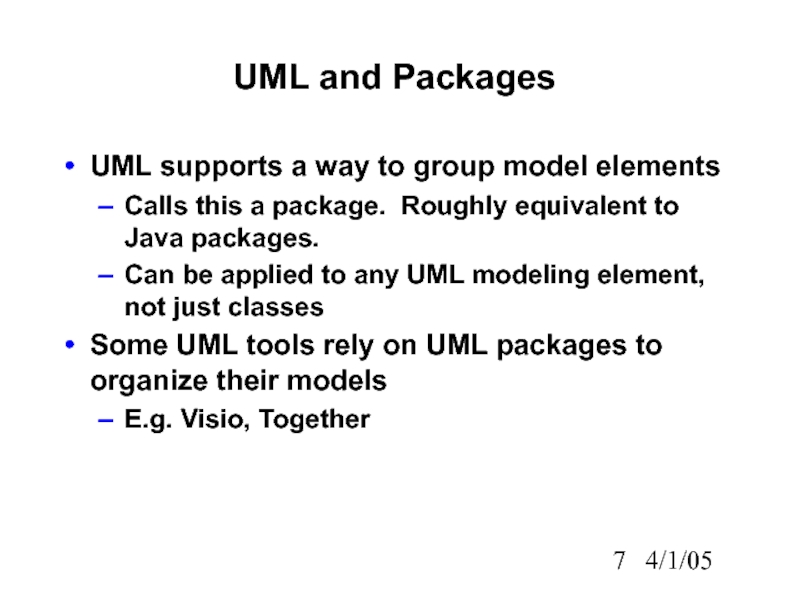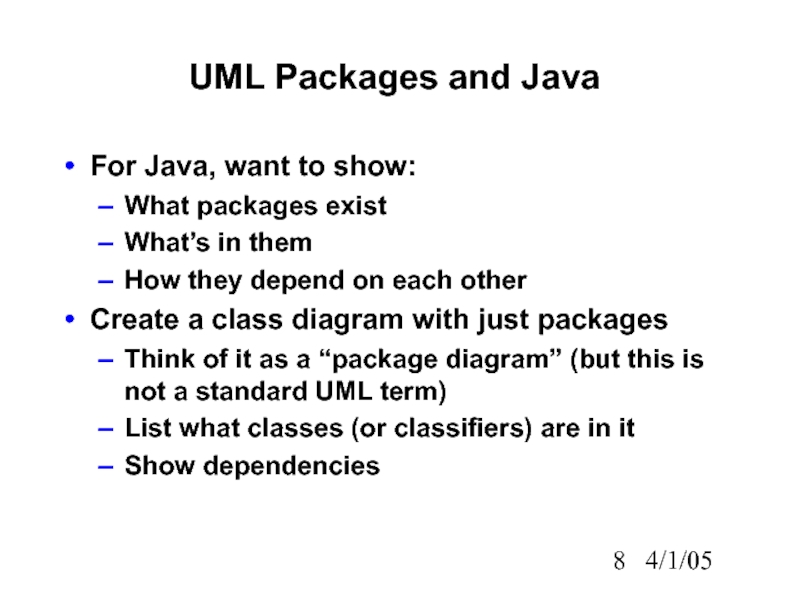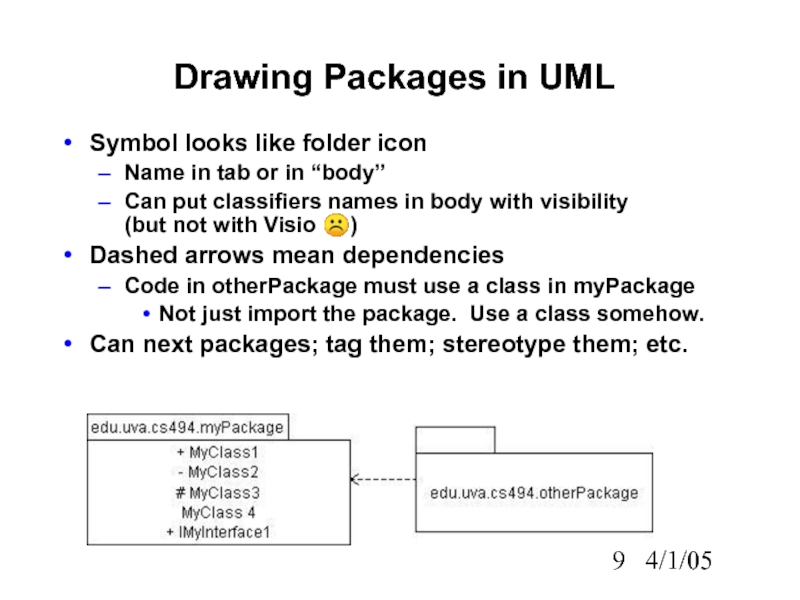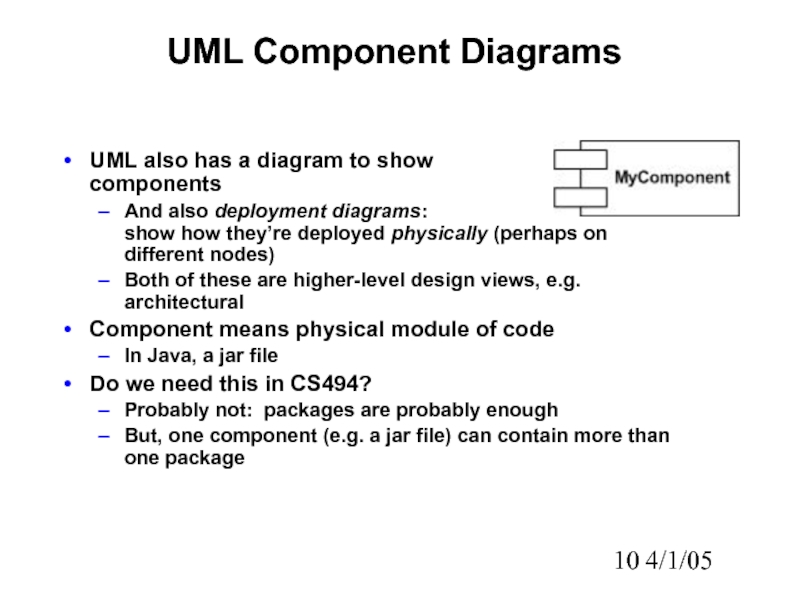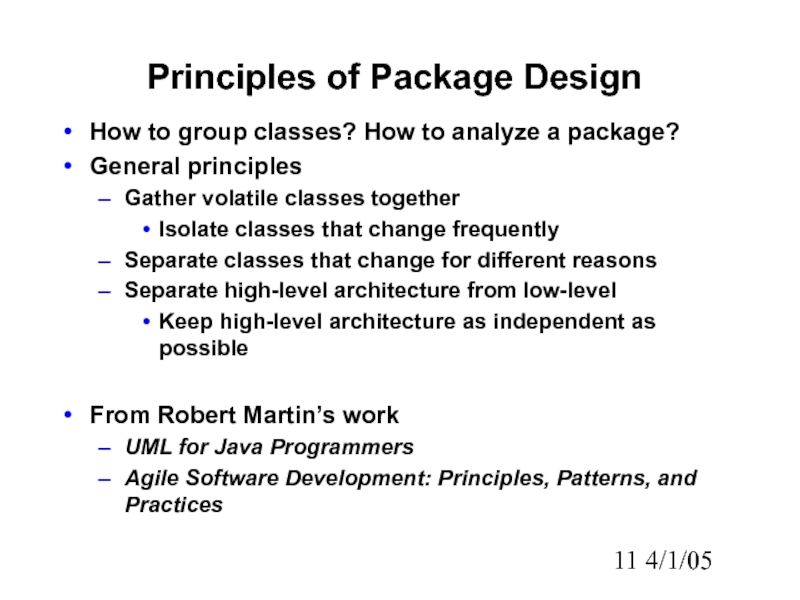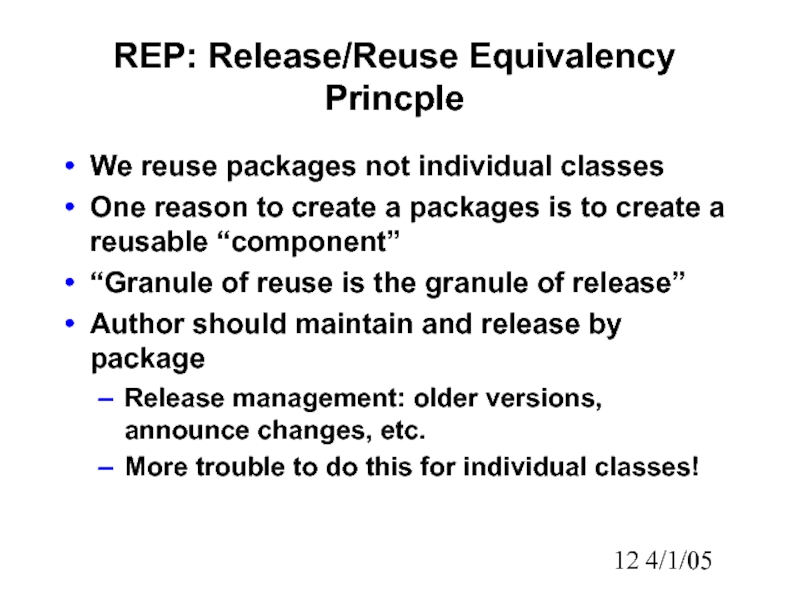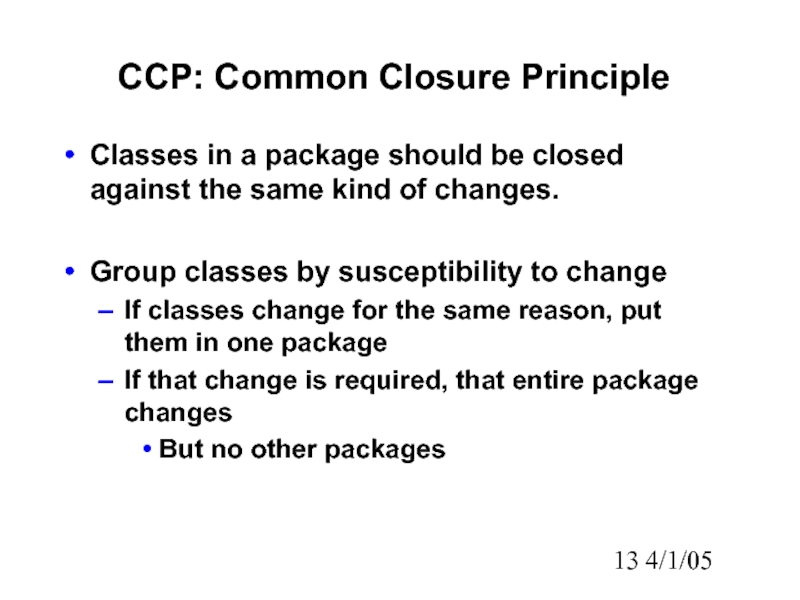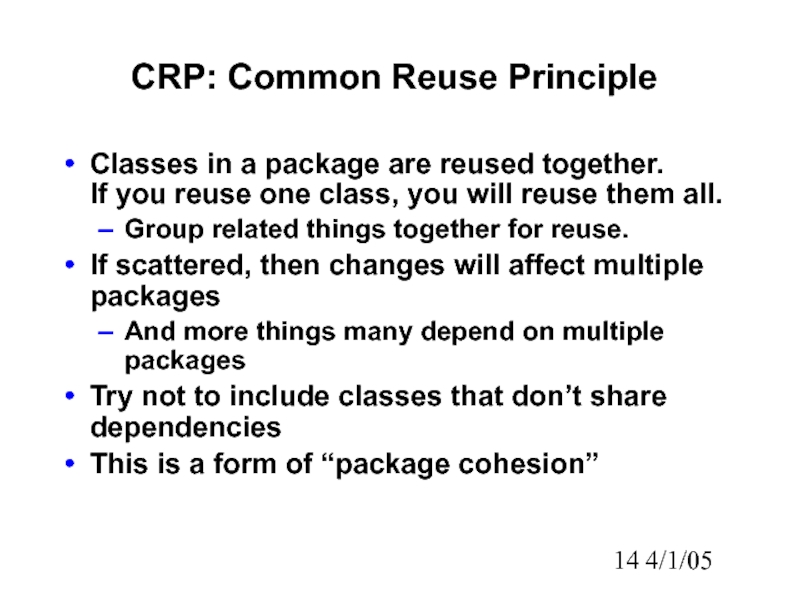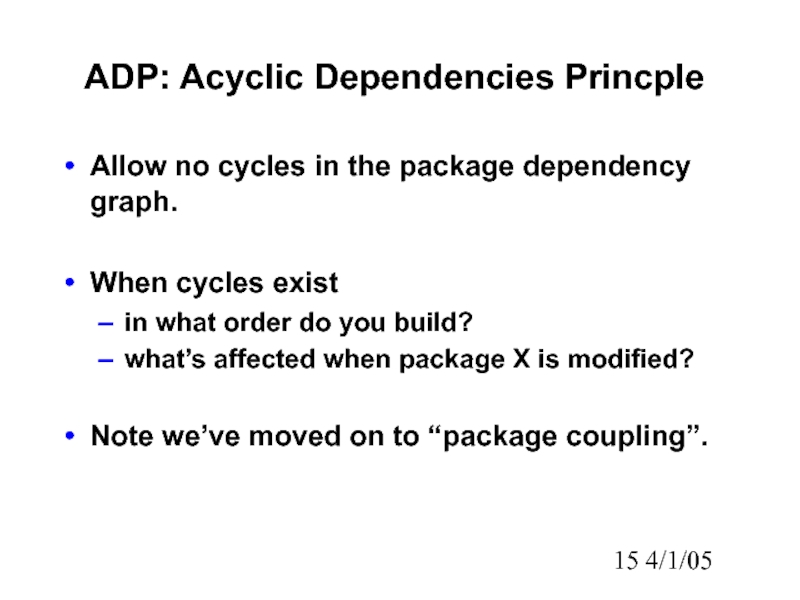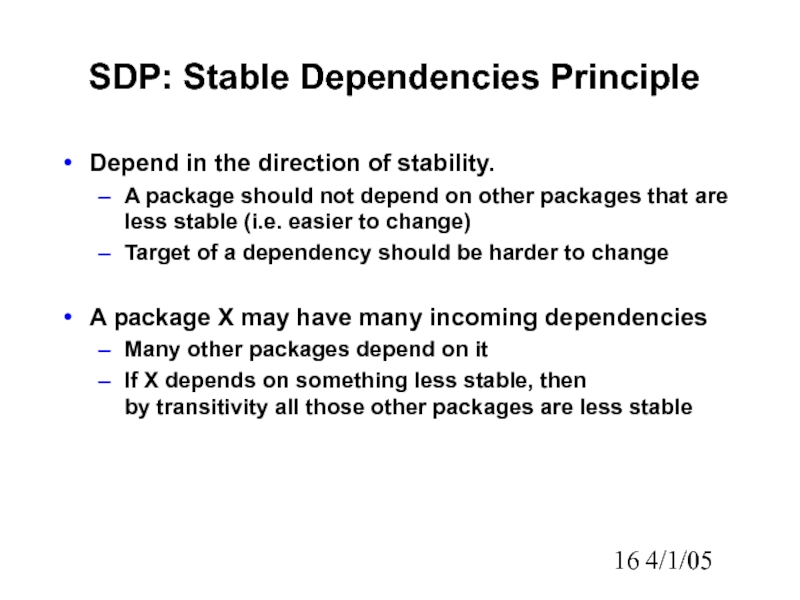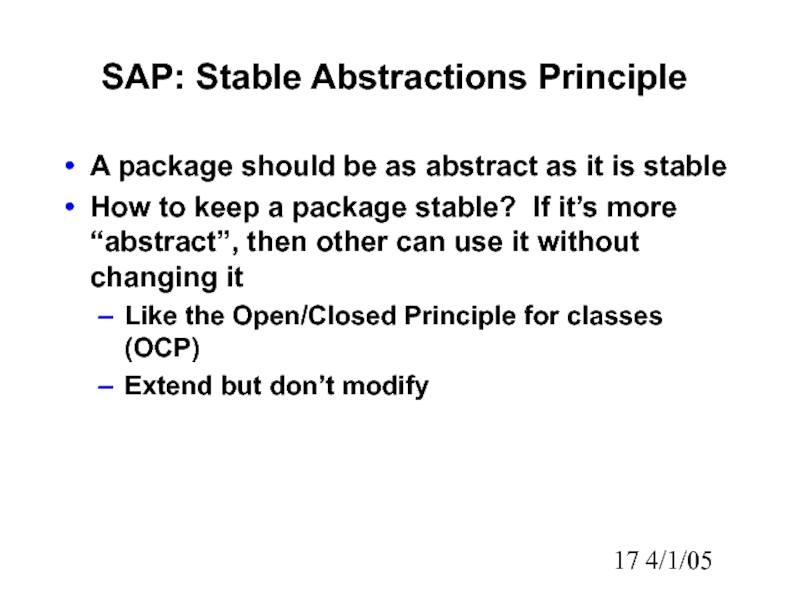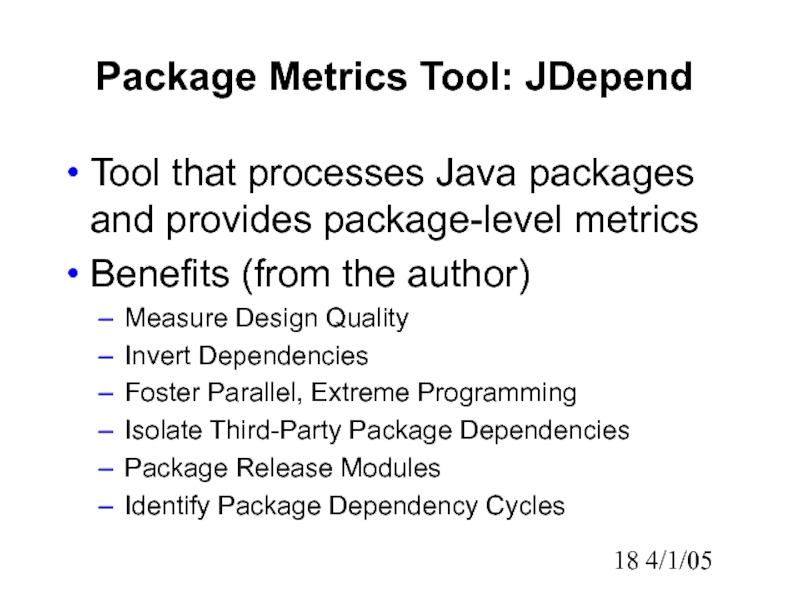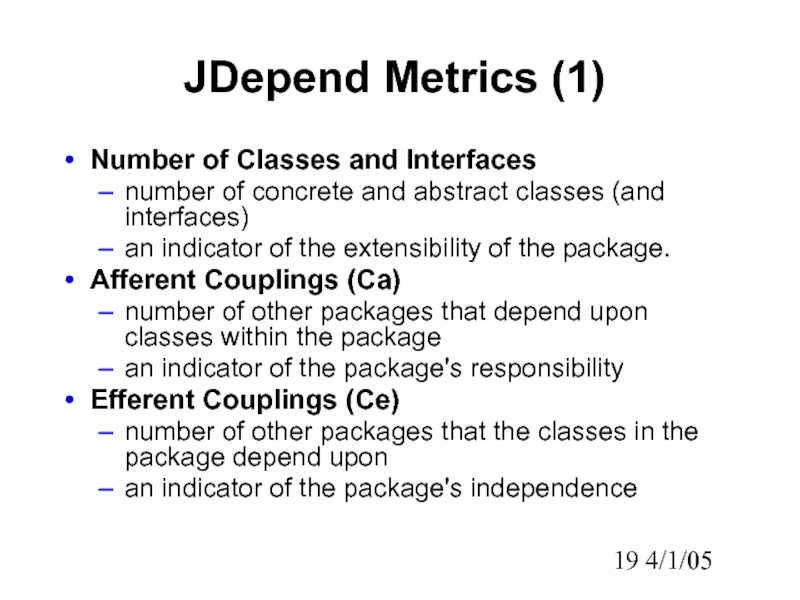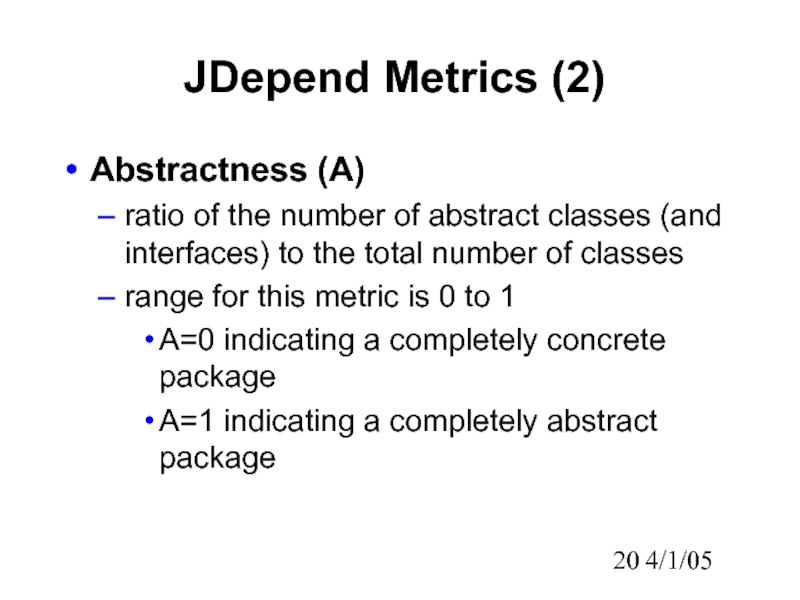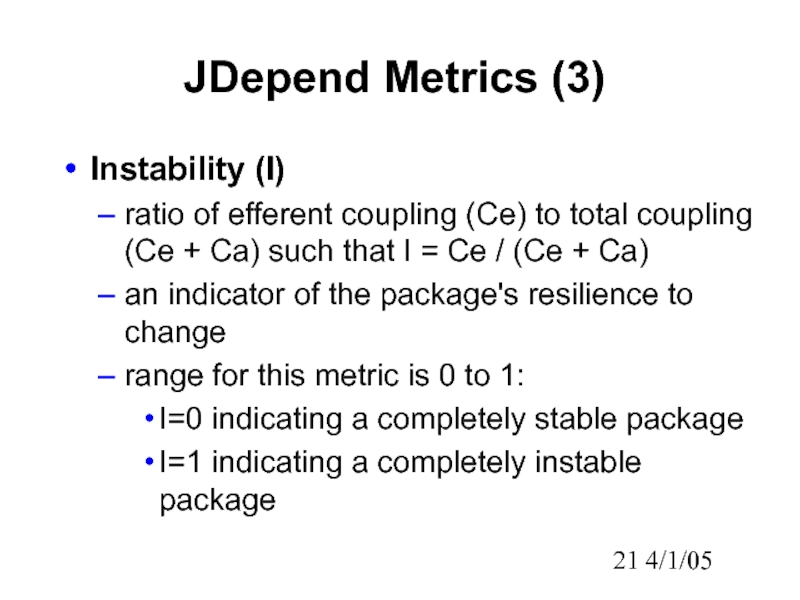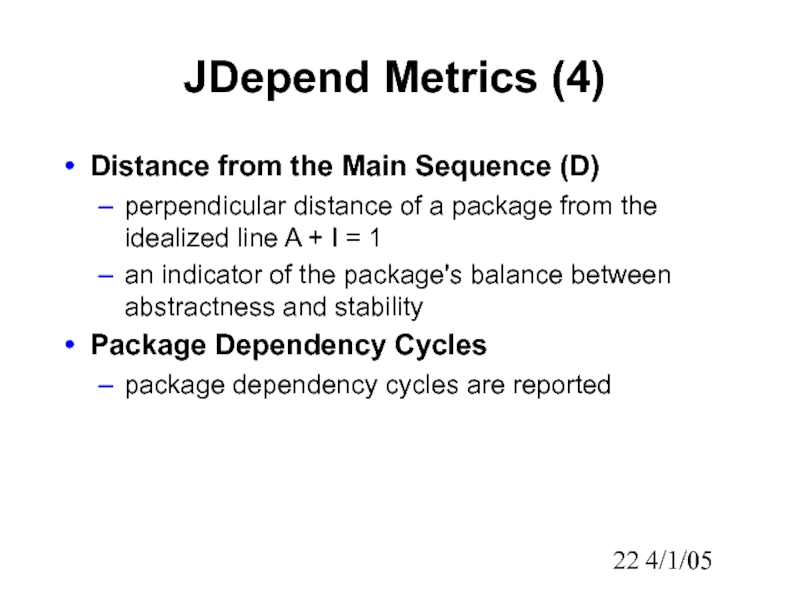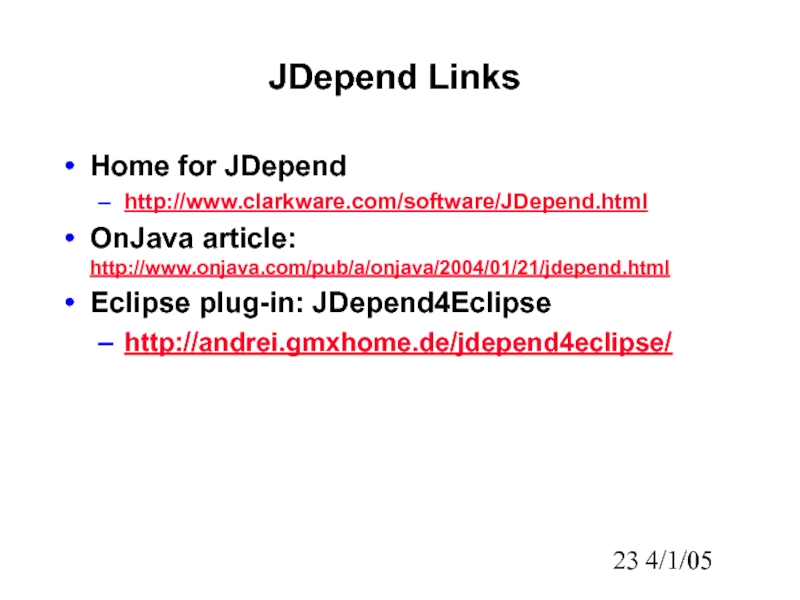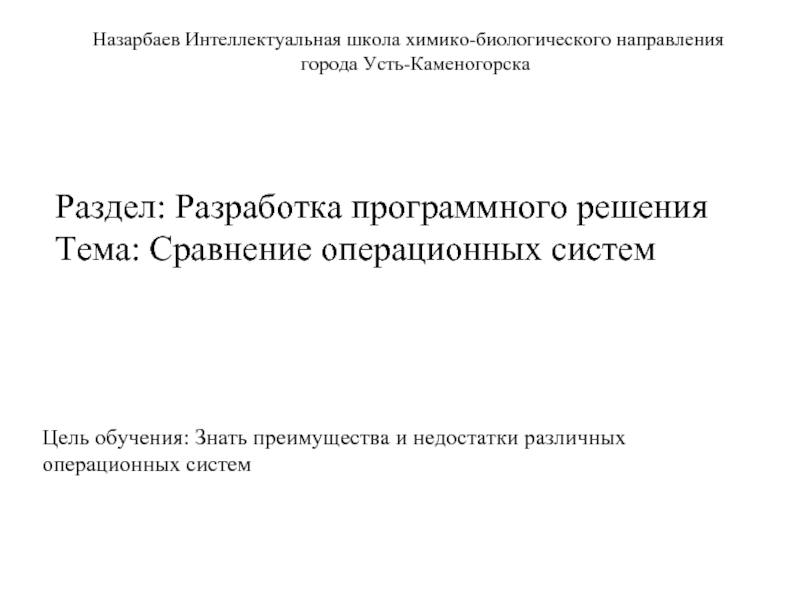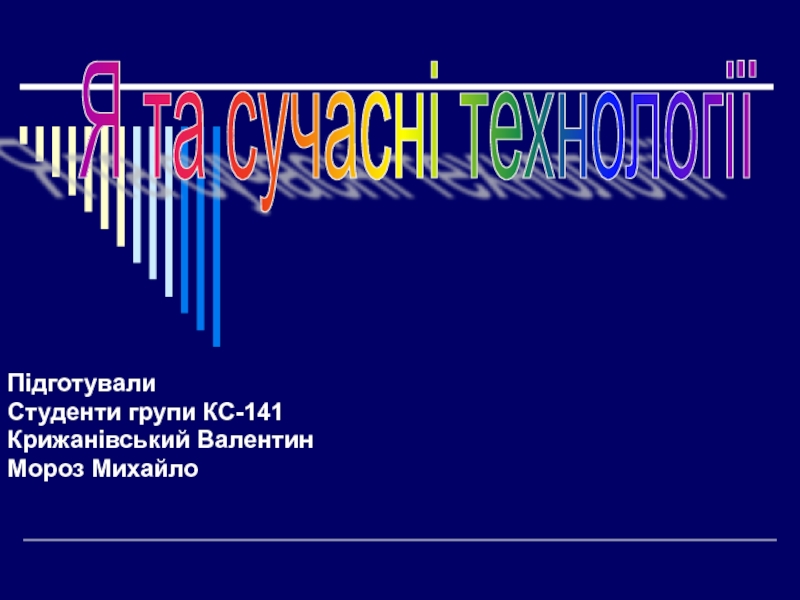Components
in Java and UML
- Главная
- Разное
- Дизайн
- Бизнес и предпринимательство
- Аналитика
- Образование
- Развлечения
- Красота и здоровье
- Финансы
- Государство
- Путешествия
- Спорт
- Недвижимость
- Армия
- Графика
- Культурология
- Еда и кулинария
- Лингвистика
- Английский язык
- Астрономия
- Алгебра
- Биология
- География
- Детские презентации
- Информатика
- История
- Литература
- Маркетинг
- Математика
- Медицина
- Менеджмент
- Музыка
- МХК
- Немецкий язык
- ОБЖ
- Обществознание
- Окружающий мир
- Педагогика
- Русский язык
- Технология
- Физика
- Философия
- Химия
- Шаблоны, картинки для презентаций
- Экология
- Экономика
- Юриспруденция
CS 494 Object-Oriented Analysis & Design презентация
Содержание
- 1. CS 494 Object-Oriented Analysis & Design
- 2. 4/1/05 Readings Any Java text on packages E.g. Just Java 1, in Chapter 5
- 3. 4/1/05 Packages in Java A collection of
- 4. 4/1/05 Packages in Java (reminders) Putting classes
- 5. 4/1/05 Compiling and Running To compile: javac
- 6. 4/1/05 jar files Bundles package directory structure(s)
- 7. 4/1/05 UML and Packages UML supports a
- 8. 4/1/05 UML Packages and Java For Java,
- 9. 4/1/05 Drawing Packages in UML Symbol looks
- 10. 4/1/05 UML Component Diagrams UML also has
- 11. 4/1/05 Principles of Package Design How to
- 12. 4/1/05 REP: Release/Reuse Equivalency Princple We reuse
- 13. 4/1/05 CCP: Common Closure Principle Classes in
- 14. 4/1/05 CRP: Common Reuse Principle Classes in
- 15. 4/1/05 ADP: Acyclic Dependencies Princple Allow no
- 16. 4/1/05 SDP: Stable Dependencies Principle Depend in
- 17. 4/1/05 SAP: Stable Abstractions Principle A package
- 18. 4/1/05 Package Metrics Tool: JDepend Tool that
- 19. 4/1/05 JDepend Metrics (1) Number of Classes
- 20. 4/1/05 JDepend Metrics (2) Abstractness (A)
- 21. 4/1/05 JDepend Metrics (3) Instability (I)
- 22. 4/1/05 JDepend Metrics (4) Distance from the
- 23. 4/1/05 JDepend Links Home for JDepend http://www.clarkware.com/software/JDepend.html
Слайд 34/1/05
Packages in Java
A collection of related classes that form a library
Also,
packages in Java are namespaces
Avoid name-clashes.
Usually means .java and .class files in a directory tree that mimics package structure
E.g. for the class called A.B.SomeClass, then the files will be:
/A/B/SomeClass.java
/A/B/SomeClass.class
Not required: could be in a database somehow
Note some IDEs (e.g. Eclipse) give a package view (better than a physical directory view of the files)
Avoid name-clashes.
Usually means .java and .class files in a directory tree that mimics package structure
E.g. for the class called A.B.SomeClass, then the files will be:
Not required: could be in a database somehow
Note some IDEs (e.g. Eclipse) give a package view (better than a physical directory view of the files)
Слайд 44/1/05
Packages in Java (reminders)
Putting classes into packages. At top of file:
package edu.virginia.cs494
No package statement in file? Still in a package: the default package
Recall if you don’t declare something public, private or protected, it has “default visibility”
“Real” programmers always use packages ☺
No package statement in file? Still in a package: the default package
Recall if you don’t declare something public, private or protected, it has “default visibility”
“Real” programmers always use packages ☺
Слайд 54/1/05
Compiling and Running
To compile: javac
Example: javac edu\uva\cs494\Foo.java
To run: java
Run-time
starts looking at one or more “package roots” for a class with the given name
Example: java edu.uva.cs494.Foo
The argument is not a file! It’s a class.
Where to look? CLASSPATH variable
Also, you can list jar files in this variable
Example: java edu.uva.cs494.Foo
The argument is not a file! It’s a class.
Where to look? CLASSPATH variable
Also, you can list jar files in this variable
Слайд 64/1/05
jar files
Bundles package directory structure(s) into one file
Like a zip file
Easier
to distribute, manage, etc.
Let Java run-time know to look in a jar file, or Make the jar file “clickable” like a .EXE file
Note: think of jar files as components (like DLLs)
If you recompile a .java file, must update the jar file
Let Java run-time know to look in a jar file, or Make the jar file “clickable” like a .EXE file
Note: think of jar files as components (like DLLs)
If you recompile a .java file, must update the jar file
Слайд 74/1/05
UML and Packages
UML supports a way to group model elements
Calls this
a package. Roughly equivalent to Java packages.
Can be applied to any UML modeling element, not just classes
Some UML tools rely on UML packages to organize their models
E.g. Visio, Together
Can be applied to any UML modeling element, not just classes
Some UML tools rely on UML packages to organize their models
E.g. Visio, Together
Слайд 84/1/05
UML Packages and Java
For Java, want to show:
What packages exist
What’s in
them
How they depend on each other
Create a class diagram with just packages
Think of it as a “package diagram” (but this is not a standard UML term)
List what classes (or classifiers) are in it
Show dependencies
How they depend on each other
Create a class diagram with just packages
Think of it as a “package diagram” (but this is not a standard UML term)
List what classes (or classifiers) are in it
Show dependencies
Слайд 94/1/05
Drawing Packages in UML
Symbol looks like folder icon
Name in tab or
in “body”
Can put classifiers names in body with visibility (but not with Visio ☹)
Dashed arrows mean dependencies
Code in otherPackage must use a class in myPackage
Not just import the package. Use a class somehow.
Can next packages; tag them; stereotype them; etc.
Can put classifiers names in body with visibility (but not with Visio ☹)
Dashed arrows mean dependencies
Code in otherPackage must use a class in myPackage
Not just import the package. Use a class somehow.
Can next packages; tag them; stereotype them; etc.
Слайд 104/1/05
UML Component Diagrams
UML also has a diagram to show
components
And also deployment
diagrams:
show how they’re deployed physically (perhaps on different nodes)
Both of these are higher-level design views, e.g. architectural
Component means physical module of code
In Java, a jar file
Do we need this in CS494?
Probably not: packages are probably enough
But, one component (e.g. a jar file) can contain more than one package
Both of these are higher-level design views, e.g. architectural
Component means physical module of code
In Java, a jar file
Do we need this in CS494?
Probably not: packages are probably enough
But, one component (e.g. a jar file) can contain more than one package
Слайд 114/1/05
Principles of Package Design
How to group classes? How to analyze a
package?
General principles
Gather volatile classes together
Isolate classes that change frequently
Separate classes that change for different reasons
Separate high-level architecture from low-level
Keep high-level architecture as independent as possible
From Robert Martin’s work
UML for Java Programmers
Agile Software Development: Principles, Patterns, and Practices
General principles
Gather volatile classes together
Isolate classes that change frequently
Separate classes that change for different reasons
Separate high-level architecture from low-level
Keep high-level architecture as independent as possible
From Robert Martin’s work
UML for Java Programmers
Agile Software Development: Principles, Patterns, and Practices
Слайд 124/1/05
REP: Release/Reuse Equivalency Princple
We reuse packages not individual classes
One reason to
create a packages is to create a reusable “component”
“Granule of reuse is the granule of release”
Author should maintain and release by package
Release management: older versions, announce changes, etc.
More trouble to do this for individual classes!
“Granule of reuse is the granule of release”
Author should maintain and release by package
Release management: older versions, announce changes, etc.
More trouble to do this for individual classes!
Слайд 134/1/05
CCP: Common Closure Principle
Classes in a package should be closed against
the same kind of changes.
Group classes by susceptibility to change
If classes change for the same reason, put them in one package
If that change is required, that entire package changes
But no other packages
Group classes by susceptibility to change
If classes change for the same reason, put them in one package
If that change is required, that entire package changes
But no other packages
Слайд 144/1/05
CRP: Common Reuse Principle
Classes in a package are reused together.
If you
reuse one class, you will reuse them all.
Group related things together for reuse.
If scattered, then changes will affect multiple packages
And more things many depend on multiple packages
Try not to include classes that don’t share dependencies
This is a form of “package cohesion”
Group related things together for reuse.
If scattered, then changes will affect multiple packages
And more things many depend on multiple packages
Try not to include classes that don’t share dependencies
This is a form of “package cohesion”
Слайд 154/1/05
ADP: Acyclic Dependencies Princple
Allow no cycles in the package dependency graph.
When
cycles exist
in what order do you build?
what’s affected when package X is modified?
Note we’ve moved on to “package coupling”.
in what order do you build?
what’s affected when package X is modified?
Note we’ve moved on to “package coupling”.
Слайд 164/1/05
SDP: Stable Dependencies Principle
Depend in the direction of stability.
A package should
not depend on other packages that are less stable (i.e. easier to change)
Target of a dependency should be harder to change
A package X may have many incoming dependencies
Many other packages depend on it
If X depends on something less stable, then by transitivity all those other packages are less stable
Target of a dependency should be harder to change
A package X may have many incoming dependencies
Many other packages depend on it
If X depends on something less stable, then by transitivity all those other packages are less stable
Слайд 174/1/05
SAP: Stable Abstractions Principle
A package should be as abstract as it
is stable
How to keep a package stable? If it’s more “abstract”, then other can use it without changing it
Like the Open/Closed Principle for classes (OCP)
Extend but don’t modify
How to keep a package stable? If it’s more “abstract”, then other can use it without changing it
Like the Open/Closed Principle for classes (OCP)
Extend but don’t modify
Слайд 184/1/05
Package Metrics Tool: JDepend
Tool that processes Java packages and provides package-level
metrics
Benefits (from the author)
Measure Design Quality
Invert Dependencies
Foster Parallel, Extreme Programming
Isolate Third-Party Package Dependencies
Package Release Modules
Identify Package Dependency Cycles
Benefits (from the author)
Measure Design Quality
Invert Dependencies
Foster Parallel, Extreme Programming
Isolate Third-Party Package Dependencies
Package Release Modules
Identify Package Dependency Cycles
Слайд 194/1/05
JDepend Metrics (1)
Number of Classes and Interfaces
number of concrete and
abstract classes (and interfaces)
an indicator of the extensibility of the package.
Afferent Couplings (Ca)
number of other packages that depend upon classes within the package
an indicator of the package's responsibility
Efferent Couplings (Ce)
number of other packages that the classes in the package depend upon
an indicator of the package's independence
an indicator of the extensibility of the package.
Afferent Couplings (Ca)
number of other packages that depend upon classes within the package
an indicator of the package's responsibility
Efferent Couplings (Ce)
number of other packages that the classes in the package depend upon
an indicator of the package's independence
Слайд 204/1/05
JDepend Metrics (2)
Abstractness (A)
ratio of the number of abstract classes
(and interfaces) to the total number of classes
range for this metric is 0 to 1
A=0 indicating a completely concrete package
A=1 indicating a completely abstract package
range for this metric is 0 to 1
A=0 indicating a completely concrete package
A=1 indicating a completely abstract package
Слайд 214/1/05
JDepend Metrics (3)
Instability (I)
ratio of efferent coupling (Ce) to total
coupling (Ce + Ca) such that I = Ce / (Ce + Ca)
an indicator of the package's resilience to change
range for this metric is 0 to 1:
I=0 indicating a completely stable package
I=1 indicating a completely instable package
an indicator of the package's resilience to change
range for this metric is 0 to 1:
I=0 indicating a completely stable package
I=1 indicating a completely instable package
Слайд 224/1/05
JDepend Metrics (4)
Distance from the Main Sequence (D)
perpendicular distance of
a package from the idealized line A + I = 1
an indicator of the package's balance between abstractness and stability
Package Dependency Cycles
package dependency cycles are reported
an indicator of the package's balance between abstractness and stability
Package Dependency Cycles
package dependency cycles are reported
